Quick answer:
The best cloud-based warehouse management system for retail is ShipHero if you need fast fulfillment and ecommerce integration, Cin7 Core for solid POS + inventory control, and Zoho Inventory for budget-conscious operations.
I’ve used or tested each of the tools on this list, and every one offers something different depending on your retail setup.
Comparison Table: At a Glance
| Tool | Pricing (Monthly) | Integrations | Mobile App | Barcode Scanning | Best For |
|---|---|---|---|---|---|
| ShipHero | $1,995+ | Shopify, Amazon | Yes | Yes | Fast-growing DTC brands |
| Cin7 Core | $349+ | Shopify, Xero | Yes | Yes | Retailers with complex inventory |
| Zoho Inventory | $39+ | Shopify, Etsy | Yes | Yes | Small businesses |
| SkuVault | $449+ | Multichannel | Yes | Yes | High-SKU ecommerce |
| NetSuite WMS | $833+ | ERP platforms | Yes | Yes | Large enterprises |
What Is a Cloud-Based Warehouse Management System?
In plain terms, a cloud-based warehouse management system (WMS) is software that helps you manage stock, orders, picking, packing, and shipping — all from a browser or app, without installing anything locally.
It's hosted on someone else’s servers, so you don’t need to worry about IT maintenance.
For retail, it’s a game-changer. Traditional WMS tools were built for big logistics teams. Cloud WMS brings the same benefits — minus the overhead — to smaller teams, even solo operators.
You can sync with your POS, track stock in real time, and route orders automatically from multiple warehouses.
These systems are ideal for omnichannel setups. If you sell through a retail store, Shopify, Amazon, and eBay all at once — this is the glue that holds it all together.
You get instant updates, fewer errors, and a clear picture of what’s in stock and where.
Best of all, cloud WMS tools scale with you. Whether you’ve got a backroom with a few shelves or multiple warehouses, these systems grow as your sales grow.
That’s why I always recommend cloud over on-premise, especially for modern retail setups.
What I Look for in a Retail Warehouse Management System
Before I recommend anything, here’s what I personally check when testing a cloud WMS for a retail client or my own ops. These points make the difference between a helpful tool and a time-waster.
- Real-time inventory sync
You want a system that syncs live with your POS. If something sells in-store, it should reflect online within seconds. Lag causes overselling, refunds, and bad reviews. - Multi-channel integrations
It needs to play nicely with Shopify, WooCommerce, Amazon, Etsy — whatever you use. The more native the integration, the smoother your operations. - Barcode scanning
Whether you use a handheld scanner or a mobile app, your WMS should allow for fast product lookup, pick-pack workflows, and receiving stock with accuracy. - Order routing and automation
Can it automatically assign orders to the right warehouse? Can it prioritize based on location or inventory levels? Manual processing slows down fulfillment. - Returns handling and adjustments
Returns happen. Your WMS should process them fast, update inventory, and keep your numbers clean. Manual tracking leads to headaches. - Mobile access
This is essential if you or your team are on the warehouse floor. Mobile apps or browser-friendly dashboards make it easy to work from anywhere.
Best Cloud-Based Warehouse Management Systems
Below is a curated list from my own experience and feedback from real retail teams. Each system includes a quick breakdown, pros and cons, pricing, and best use cases.
1. ShipHero
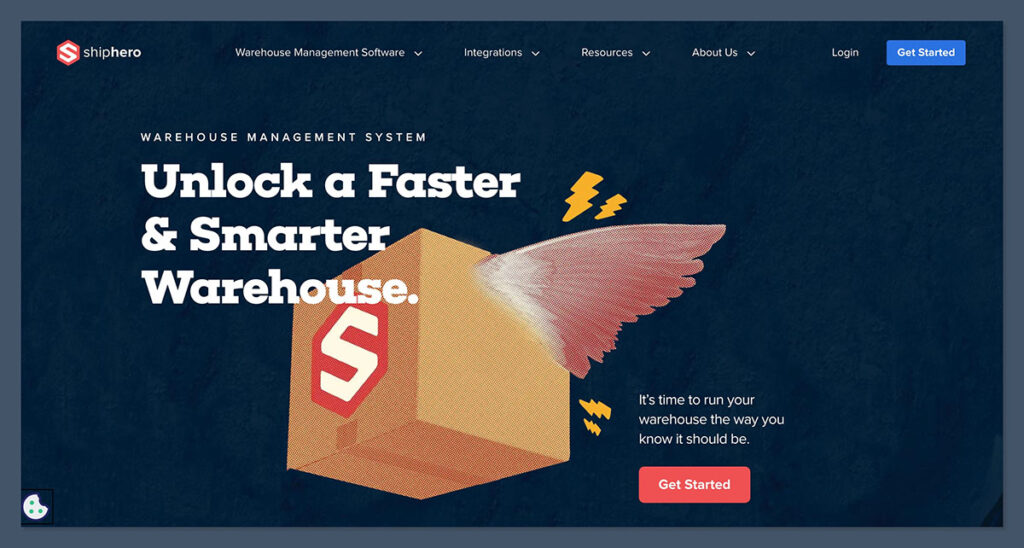
ShipHero is built for ecommerce and DTC brands that need fast, accurate fulfillment.
It supports multiple warehouses, real-time tracking, and tight integrations with platforms like Shopify, Amazon, and BigCommerce. If you want something scalable and fast — ShipHero delivers.
What sets ShipHero apart is how tightly it weaves warehousing and fulfillment with ecommerce platforms. Unlike traditional WMS tools that feel bolted-on, ShipHero was built from the ground up for direct-to-consumer sellers.
You get real-time inventory visibility, optimized picking routes, and shipping labels printed automatically — all within the same dashboard.
For businesses managing their own warehouse, ShipHero offers robust tools to streamline internal operations. If you prefer hands-off logistics, their 3PL network can fulfill orders on your behalf using their software.
You don’t need to switch systems — just flip the fulfillment method.
The user interface is intuitive enough for new hires to get up and running in a day.
And if you're moving high order volumes, the automation workflows can save hundreds of hours every month by handling routine warehouse decisions behind the scenes.
Pros:
- Fast onboarding and easy to use
- Integrates with major ecommerce platforms like Shopify, Amazon, BigCommerce, WooCommerce
- Offers 3PL fulfillment as a service with real-time visibility
- Powerful automation tools to reduce manual workflows
- Cloud-based with iOS app support for mobile warehouse operations
Cons:
- Overkill for very small retailers
- Pricing is steep for lean budgets
- Not ideal for B2B workflows or wholesale order types
- Limited accounting and procurement features — needs integration
Pricing:
| Plan Type | Cost | Notes |
|---|---|---|
| Software License | $1,995/month | Core WMS platform for in-house operations |
| Fulfillment Services | Varies | Priced per order and storage, custom quote |
| Implementation & Setup | Custom | One-time onboarding fees may apply |
Pricing is based on warehouse size, order volume, and feature needs. ShipHero’s fulfillment network can be used independently or in combination with your in-house warehouse.
Best For:
Growing ecommerce brands doing high order volumes who want their own warehouse and/or outsource fulfillment to ShipHero’s 3PL network.
If you're shipping 500+ orders per month and managing inventory across multiple sales channels, ShipHero can drastically reduce your fulfillment headaches. It’s also a strong choice for brands ready to scale operations without hiring a large warehouse team.
2. Cin7 Core
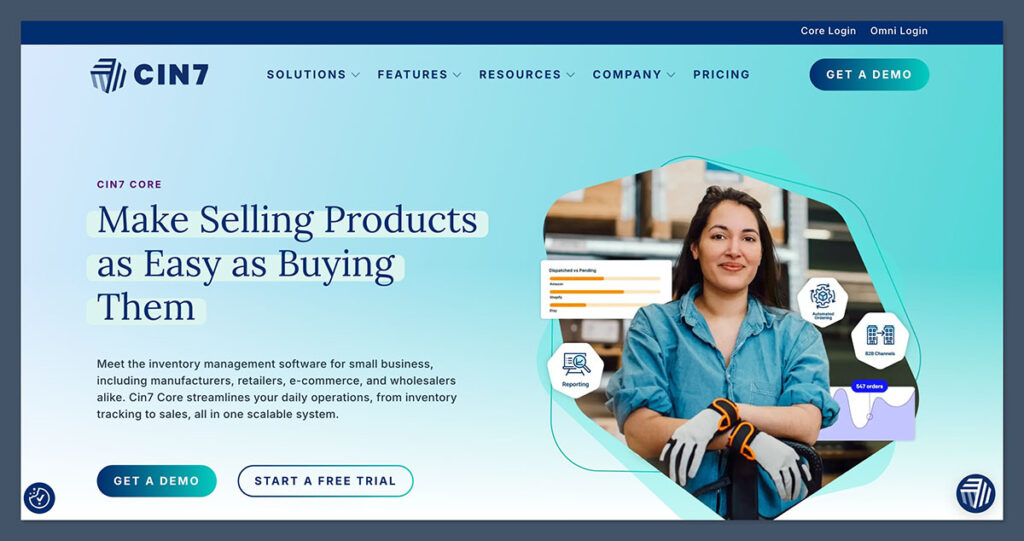
Formerly known as DEAR Systems, Cin7 Core is a powerhouse when it comes to inventory-heavy retail.
It’s built for businesses that need more than just basic stock tracking — think kitting, component-level control, purchase orders, batch tracking, and even light manufacturing.
If you’ve got hundreds or thousands of SKUs and need to stay organized across multiple sales channels and retail locations, this tool does the heavy lifting.
Cin7 Core shines when it’s paired with a point-of-sale system. It syncs in real time, allowing you to track stock across your storefront and warehouse without delay.
It also supports barcode scanning, multiple price lists, and automated reordering, giving you tight control over your stock and margins.
Another strength is its ability to handle complex product types. Whether you sell kits, bundles, or custom-built products, the system lets you create assemblies or bill-of-materials without needing full-blown manufacturing software.
This flexibility is perfect for retailers who occasionally need light production workflows.
Despite its power, Cin7 Core isn’t the most beginner-friendly. It’s feature-rich, and the interface can feel dense if you’re coming from simpler tools.
But once it’s set up properly, it becomes a central hub for all your inventory and operational decisions.
Pros:
- Deep inventory control with real-time syncing
- Works well with POS systems including Cin7’s native POS
- Handles kitting, bundling, light manufacturing, and B2B workflows
- Strong reporting and forecasting for purchase planning
- Supports batch and serial number tracking
Cons:
- Can be too complex for simple use cases or startups
- Steeper learning curve for users without inventory background
- Support response times can lag during peak seasons
- Interface feels dated in parts and could use design updates
Pricing:
| Plan Type | Cost | Notes |
|---|---|---|
| Standard Plan | $349/month | Includes basic features for one user |
| Additional Users | $60/month | Charged per user |
| Advanced Features | Custom | Add-ons for manufacturing, automation, etc. |
| Onboarding Support | Custom Quote | Optional implementation assistance from Cin7's team |
Pricing increases quickly as you scale users or enable additional features, so it’s best suited for businesses already dealing with large volumes.
Best For:
Mid-sized retailers with complex product catalogs, in-store and online sales, and a need for deep inventory visibility.
If your business sells bundled products, has multiple warehouses, or manages inventory across retail, wholesale, and ecommerce, Cin7 Core can centralize everything. It’s not cheap or simple — but it’s one of the most capable WMS platforms available for modern retail operations.
3. Zoho Inventory
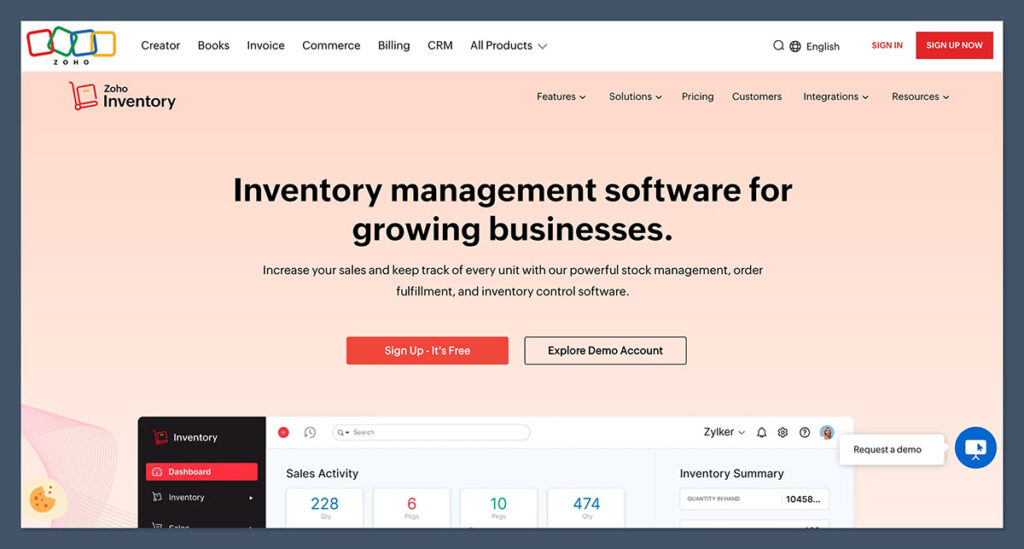
Zoho Inventory is the most budget-friendly option on this list, and that’s exactly what makes it appealing to small ecommerce shops and independent retailers.
It covers the essential functions you'd expect from a warehouse management system: stock tracking, order fulfillment, barcode generation, and multichannel integrations — all packed into a simple, easy-to-use interface.
Where Zoho stands out is in its seamless integration with the rest of the Zoho ecosystem. If you're already using Zoho Books, Zoho CRM, or Zoho Commerce, this WMS becomes a natural extension of your stack.
Even if you’re not deep into the Zoho suite, the tool still holds its own by connecting easily to Shopify, Etsy, Amazon, eBay, and more.
Zoho Inventory is cloud-based and doesn’t require a steep learning curve. You can set it up in a day, link your channels, and start syncing stock with minimal fuss.
It even includes features like batch tracking, serial numbers, and automated reorder points, which are typically reserved for higher-tier tools.
That said, it's not a complete solution for fast-growing or high-volume operations. It lacks deeper automation, built-in warehouse workflows like wave picking, and dedicated fulfillment tools.
But for the price, it does more than enough for businesses still finding their footing.
Pros:
- Affordable plans that scale gradually with your business
- Clean interface with minimal setup required
- Tracks serial numbers, batch items, and expiration dates
- Syncs with ecommerce platforms and online marketplaces
- Native integration with other Zoho products (Books, CRM, etc.)
Cons:
- Limited warehouse automation tools (e.g., no advanced picking or routing)
- Forecasting and advanced analytics are weak or require external tools
- No in-house fulfillment or 3PL services
- API support is limited compared to enterprise systems
Pricing:
| Plan Type | Cost (Monthly) | Features Included |
|---|---|---|
| Free Plan | $0 | Limited to 50 orders/month and 1 warehouse |
| Standard | $39 | 1,500 orders/month, 2 warehouses, basic integrations |
| Professional | $79 | 7,500 orders/month, 5 warehouses, batch/serial tracking |
| Premium | $199 | 30,000 orders/month, 10 warehouses, advanced automations |
| Elite | $329 | 60,000 orders/month, multi-user, priority support |
Zoho also offers annual billing discounts and bundles with its other tools.
Best For:
Small ecommerce shops and retailers needing low-cost WMS with core inventory tracking.
If you’re just getting started and need a no-fuss inventory management system that plays well with your ecommerce platforms, Zoho Inventory is a smart first choice. It’s ideal for operations that are still lightweight but want to get ahead of inventory problems before they scale.
4. SkuVault
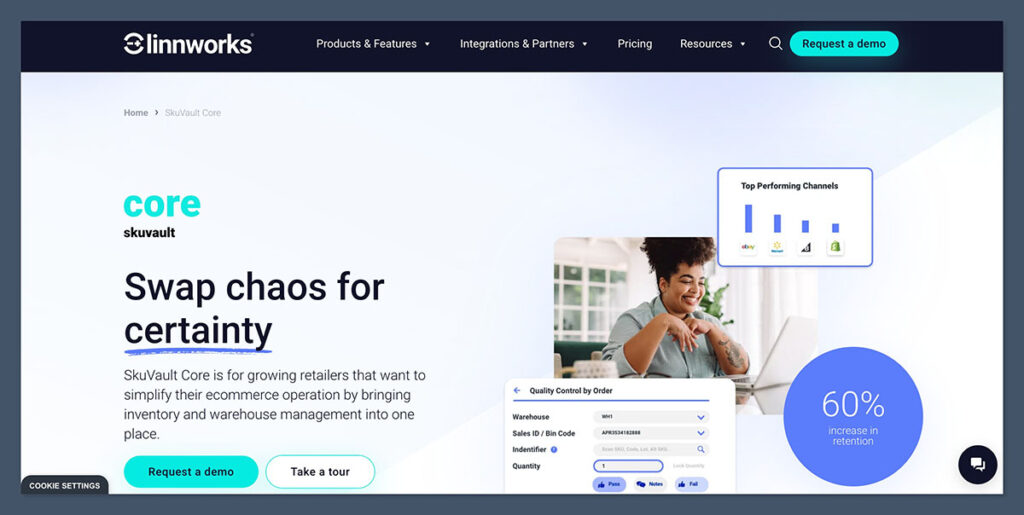
SkuVault is purpose-built for high-SKU, multichannel ecommerce sellers.
If you're managing inventory across multiple warehouses, suppliers, and sales platforms — and constantly dealing with stockouts, overselling, or mis-picks — SkuVault helps you tighten things up fast.
It’s designed to improve operational accuracy through real-time inventory syncing, barcode scanning, and advanced picking strategies. What makes SkuVault stand out is how well it handles large product catalogs.
Even with thousands of SKUs, it gives you control without slowing you down.
The system syncs with all major platforms like Shopify, Amazon, Walmart, eBay, and more.
It also supports kitting and bundling, so if you're selling product packs or assembled SKUs, the system keeps the underlying components tracked and updated automatically.
Where it really excels is in picking and packing workflows. It uses guided pick routes and scan-to-verify steps to reduce errors in the warehouse.
These workflows help teams pick faster, cut down returns, and improve customer satisfaction.
Pros:
- Live inventory syncing across multiple sales channels and warehouses
- Barcode scanning with scan-to-pick and scan-to-ship features
- Customizable picking logic and warehouse mapping
- Good customer support with onboarding assistance
- Helps prevent stockouts and overselling with reorder point automation
Cons:
- UI feels outdated and not as modern as newer tools
- Setup and customization can take time, especially for complex catalogs
- Some integrations may require third-party connectors or manual upkeep
- Advanced features require deeper configuration to get full value
Pricing:
| Plan Type | Cost (Monthly) | Features Included |
|---|---|---|
| Standard | $449+ | Core WMS tools, multichannel sync, basic barcode workflows |
| Advanced | Custom Quote | Additional users, advanced automations, more integrations |
| Onboarding Fee | Varies | Optional setup support available from the SkuVault team |
Pricing is usage-based and scales with order volume, integrations, and user seats. SkuVault also offers enterprise-level solutions with custom workflows and reporting.
Best For:
Retailers managing 1,000+ SKUs across marketplaces and warehouses.
If you're operating at scale and tired of juggling spreadsheets or underpowered WMS tools, SkuVault brings the stability and accuracy you need. It’s best for teams that can dedicate time to initial setup and want to reduce warehouse errors and overselling long-term.
5. NetSuite WMS
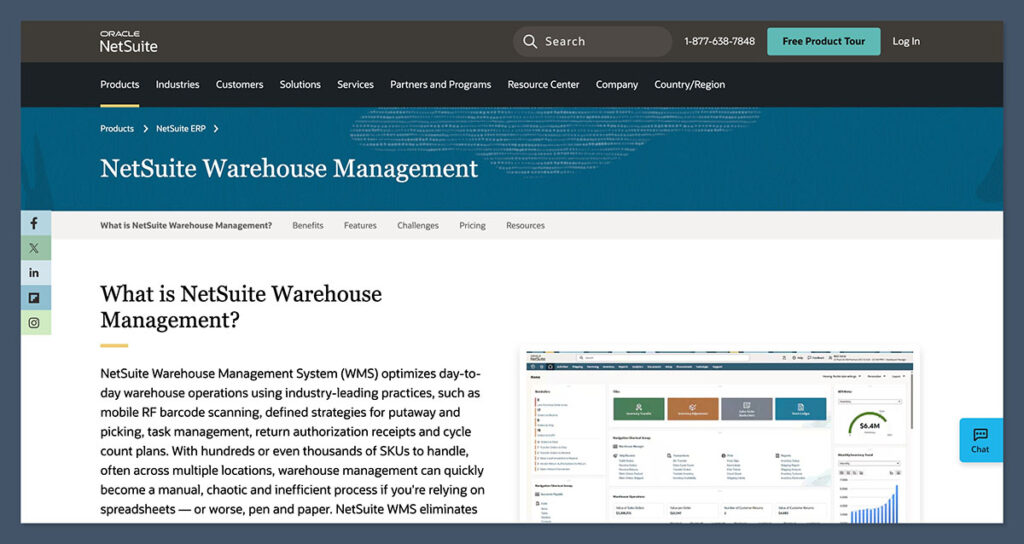
NetSuite’s Warehouse Management System (WMS) is part of Oracle’s extensive ERP suite, designed for enterprise-level businesses that need a centralised platform to manage everything — from finance to inventory to warehouse operations.
If you're running multiple physical locations, warehouses, departments, and sales channels, NetSuite brings all those moving parts under one umbrella.
This isn’t a standalone warehouse app — it's a full ERP with advanced warehouse management features built in.
That means your warehouse data flows directly into accounting, purchasing, sales, CRM, and ecommerce functions.
There’s no syncing delays, no external API limits, and fewer software silos to deal with.
The WMS module offers advanced functionality: wave picking, mobile RF scanning, putaway strategies, cycle counting, and task management.
These features are designed to improve accuracy, reduce manual effort, and scale with large teams. It also supports regulatory compliance, lot tracking, and real-time dashboards that help execs and ops teams stay aligned.
That said, NetSuite WMS is not for small or even mid-sized teams. Implementation is a major investment — not just financially, but in time and change management.
The upside? Once you’ve got it running, everything is in one place. You’ll rarely outgrow it.
Pros:
- Fully integrated with NetSuite ERP: finance, inventory, CRM, purchasing
- Built for scale — handles complex, high-volume operations
- Robust automation tools including wave picking and task allocation
- Custom workflows tailored to retail, wholesale, and manufacturing
- Strong audit trails and compliance capabilities
Cons:
- Expensive and often requires long-term contracts
- Steep learning curve across teams and departments
- Implementation can take several months or more
- Requires technical support for customizations and reporting
Pricing:
| Cost Component | Estimate | Notes |
|---|---|---|
| Base License | $10,000+/year | Includes WMS functionality as part of NetSuite ERP |
| Setup & Implementation | $25,000–$100,000+ | Costs vary based on size, modules, and custom workflows |
| Ongoing Support | Custom Quote | Enterprise-grade support packages available |
| Add-ons | Variable | Advanced features like manufacturing, demand planning, etc. |
NetSuite pricing is highly variable and customized per client, based on business size, number of users, and specific modules enabled.
Best For:
Large retailers and wholesalers needing a single system for finance, inventory, purchasing, and warehouse control.
If your business has outgrown standalone tools and you're tired of disconnected systems, NetSuite WMS offers end-to-end visibility and control.
It’s the type of investment you make when you're optimizing operations at scale and need a platform that can handle the complexity for years to come.
Which One’s Right for You?
Choosing the right cloud-based WMS comes down to your current business model, team size, budget, and complexity.
There's no one-size-fits-all tool here — and trying to implement a system that's too big or too basic for your needs will just slow you down.
Here’s a breakdown of who each platform fits best, based on real-world retail use cases:
Budget retail operations
→ Go with Zoho Inventory
If you're a small ecommerce seller or independent retailer trying to keep costs down, Zoho Inventory is the best entry point. It’s low-cost, easy to learn, and gives you all the core features to track stock, manage orders, and sync sales channels.
- Ideal for Shopify and Etsy stores
- Works great for businesses shipping 50 to 1,000 orders/month
- Gives room to grow without locking you into big contracts
Scaling ecommerce stores
→ Try ShipHero
When you're hitting hundreds of orders a day and need fulfillment speed, accuracy, and multi-warehouse support, ShipHero is hard to beat. It’s designed for growth and takes warehouse chaos out of the equation.
- Perfect for fast-growing DTC brands
- Use in-house or pair with ShipHero’s 3PL
- Best for Shopify, Amazon, BigCommerce, and WooCommerce
POS-heavy retail
→ Use Cin7 Core
If you run a retail store and online shop — and need stock synced in real time between both — Cin7 Core is your match. It’s strong on product-level control and integrates tightly with point-of-sale systems.
- Supports bundling, kitting, and assembly
- Ideal for multi-location retail operations
- Great for businesses that mix in-store and ecommerce
High SKU count operations
→ Get SkuVault
SkuVault works best when you're dealing with a complex catalog, multiple warehouses, and lots of moving parts. If your team is drowning in spreadsheets and inventory mistakes, this tool can bring order.
- Designed for 1,000+ SKUs and high-volume marketplaces
- Great for Amazon, Walmart, and multi-channel sellers
- Optimizes warehouse picking and packing
Enterprise setups
→ Choose NetSuite
For large retailers or wholesale distributors who need everything — finance, purchasing, inventory, CRM, and warehouse management — under one system, NetSuite is the most complete solution.
- Built for national or global operations
- Fully integrated with accounting and forecasting
- Best for teams ready to commit to a full ERP system
Final Takeaway
Pick the tool that matches your current operations — not your wishlist for two years from now. It’s much easier (and cheaper) to upgrade later than it is to rip out a system that doesn’t fit.
The real cost isn’t just the software. It’s the time it takes your team to learn it, configure it, and actually use it every day without friction. Start lean, build smart, and scale when the pain points get real.





Comments 0 Responses